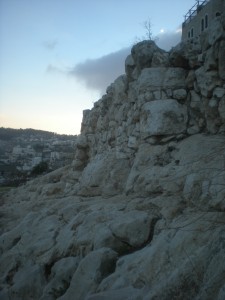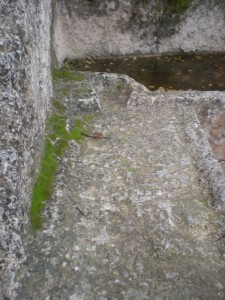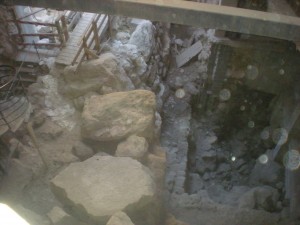
Our siyur (tour) this past Tuesday started in my backyard, almost literally. We met at the Tayelet / Haas Promenade, a mere 5-minute walk from my apartment in beautiful Arnona, Jerusalem. This scenic outlook offers an excellent spot to view the geography of ancient Jerusalem. From there, we went to a semi-hidden and little known spot called Ketef Hinnom (Shoulder of Hinnom, a valley in Jerusalem), then hiked through Gei Ben-Hinnom / the Hinnom Valley, and came out at the bottom of Ir David / City of David. We spent the rest of the day winding our way up, down and back up again inside this complex and interesting archaeological site.
I am not going to go into too much detail about Ir David, especially since I already discussed it a bit in this post here, but I did want to discuss a few interesting points from throughout the day. I also want to discuss two recent news stories that relate to things we learned about.
Beginning on the Tayelet, we used the story of King David’s conquest of Jebus (the city that would later be named Jerusalem) as a frame for the day’s activities. The march on Jebus was the very first thing mentioned in 2 Samuel 5 after David’s coronation. Our guide for the day pointed out how the tribes of Israel coming together to appoint David as their king was an early example of democracy. The Biblical passage there twice uses the word “all” in reference to the tribes joining together, thus stressing their unity. At the same time, David’s covenant with the tribes of Israel was made “before God,” indicating a priority of his monarchy.
Later, inside Ir David, we examined the geography of the city itself. Solomon, David’s son and successor, built the Holy Temple on Mount Moriah, higher than the city itself. He built his own palace beneath the temple, but also above the city. Thus, while the monarchy is above the people, he visually maintained the priority that David had placed in keeping the kingship below God.

Ketef Hinnom is one of those really cool spots in Jerusalem that lies right under people’s noses, and yet most people have never been there, let alone even heard of it. Sitting on a small hilltop situated between the old train station, St. Andrew’s Scottish Guest House and Derech Hevron / Hebron Road, this is a piece of the ancient road that ran through the region. It is, in fact, very clearly mentioned in some passages of the Bible. Joshua 15:8 describes the border between Judah and Benjamin:
And the border went up by the Valley of the son of Hinnom unto the side of the Jebusite southward–the same is Jerusalem–and the border went up to the top of the mountain that lieth before the Valley of Hinnom westward, which is at the uttermost part of the vale of Rephaim northward.
Ketef Hinnom is the mountain that is west of the Valley of Hinnom and north of Emek Refaim / Rephaim Valley.
But the most interesting discovery on Ketef Hinnom was a series of First Temple-era burial caves. (The caves have since been removed, but their insides remain.) We can learn a lot about a people by their burial rites, and the ancient burial methods of the Israelites would probably seem quite foreign to modern Jews. For example, the bodies were laid out on top of stone slabs (a carved stone “pillow” held the skull in place once the body decomposed). The relatives would return at a later date, once the body had decomposed, and put the bones into a communal pit beneath the tomb, along with the bones of relatives from prior generations. Thus, a dead person very literally “slept with his fathers,” a common phrase mentioned in the Bible.
Perhaps even more surprising to contemporary Jews was the practice of burying the dead with artifacts that were important to them in life. It is this very practice that led to one of the most remarkable archaeological finds at this site. Among many other items found here were two silver amulets that once unrolled (a difficult process in itself) revealed writing of the Priestly Blessings. These are the earliest extant documents of any passages from the Torah, the Five Books of Moses, predating the earliest Dead Sea Scrolls by about 100 years.
Moving on to Ir David, one of the things that makes it such a complex archaeological site is that it was a major city for such a long time, and was heavily fortified throughout this time. Thus, there are many archaeological features that stem from various times, some of which were used continually and others which were modified in different eras. Thus, it seems that the more that is discovered in this area, the more questions that are raised, even while seemingly answering other questions.

A good example of this is the water system. Ir David was supplied with water by the Gihon Spring. Two different conveyance tunnels, three different pools (one of which may have been deepened in a second era), a fortified tower to protect the spring, an underground “secret” tunnel, and a vertical shaft are among the many archaeological finds that are in some way connected with this water system. Built in different eras, some features undid the work of other eras. Trying to figure out how these all fit together is part of the challenge of understanding this site, and trying to make it interesting and understandable to a group of tourists is the unique task of a tour guide!
Lastly, I wanted to mention two recent news stories.
Firstly, at Ketef Hinnom we discussed literacy among the ancient Israelites. Curses written on the outside of tombs to ward off graverobbers suggests that even the robbers back then may have been literate. And the amulets I mentioned before include passages from the Hebrew Bible that date to around 600 BCE.
Another recent discovery, however, shows that the written Hebrew language (as well as a strong moral code) go back even further in Judea. If verified, this inscription would be the earliest example of Hebrew writing, from the 10th Century BCE. This was the era of King David’s reign.
This breakthrough indicates that at least some of the scriptures were composed hundreds of years before the dates previously believed, and that the Kingdom of Israel already existed at that time.
Furthermore, the text relates to a social code regarding slaves, widows and orphans.
1 you shall not do [it], but worship the [Lord].
2 Judge the sla[ve] and the wid[ow] / Judge the orph[an]
3 [and] the stranger. [Pl]ead for the infant / plead for the po[or and]
4 the widow. Rehabilitate [the poor] at the hands of the king.
5 Protect the po[or and] the slave / [supp]ort the stranger.
This is in keeping with passages on social justice from Zechariah 7, Jeremiah 7 and (quoted here) Exodus 22:
And a stranger shalt thou not wrong, neither shalt thou oppress him; for ye were strangers in the land of Egypt. Ye shall not afflict any widow, or fatherless child. If thou afflict them in any wise–for if they cry at all unto Me, I will surely hear their cry.
The other story I wanted to mention also relates to a recent archaeological find.
A site like Ir David, which includes major structures that are 3700 years old, seems like it is truly ancient. And it is. Especially compared to a contemporary Israel in which Tel Aviv, the first modern Jewish City, recently celebrated its 100th anniversary.
Just today, however, an archaeological dig in that very city of Tel Aviv announced a major finding: remnants of a building from around 6000 BCE! They even found artifacts that date as far back as 100,000 BCE.
“For the first time, we have encountered evidence of a permanent habitation that existed in the Tel Aviv region 8,000 years ago,” [Archaeologist Ayelet Dayan] said. “The site is located on the northern bank of the Yarkon River, not far from the confluence with Nahal Ayalon. It is assumed that this fact influenced the ancient settlers in choosing a place to live. The fertile alluvium soil along the fringes of the streams was considered a preferred location for a settlement in ancient periods.”
Really makes you realize how significant this narrow strip of land has always been, as a birthplace of civilization!
